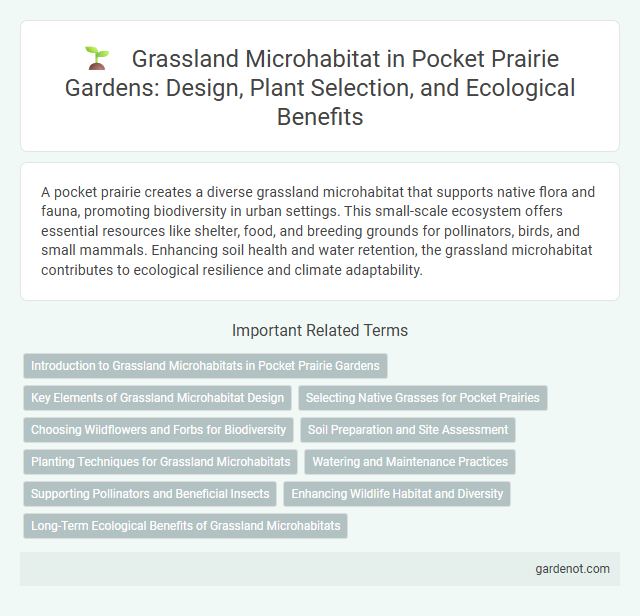A pocket prairie creates a diverse grassland microhabitat that supports native flora and fauna, promoting biodiversity in urban settings. This small-scale ecosystem offers essential resources like shelter, food, and breeding grounds for pollinators, birds, and small mammals. Enhancing soil health and water retention, the grassland microhabitat contributes to ecological resilience and climate adaptability.
Introduction to Grassland Microhabitats in Pocket Prairie Gardens
Grassland microhabitats in pocket prairie gardens support diverse native plant species and provide essential resources for pollinators, birds, and beneficial insects. These microhabitats recreate the complex structure of natural prairies, featuring layered vegetation from grasses like big bluestem and switchgrass to native wildflowers such as purple coneflower and black-eyed Susan. By fostering soil health and promoting biodiversity, pocket prairie grasslands contribute significantly to urban ecological resilience and ecosystem services.
Key Elements of Grassland Microhabitat Design
Key elements of grassland microhabitat design include native prairie grasses such as little bluestem and switchgrass, which provide structural diversity and promote biodiversity. Incorporating diverse flowering forbs like purple coneflower and black-eyed Susan supports pollinators and enhances ecosystem resilience. Soil health, achieved through deep root systems and organic matter incorporation, is critical for sustaining nutrient cycling and water retention in pocket prairies.
Selecting Native Grasses for Pocket Prairies
Selecting native grasses for pocket prairies enhances biodiversity and supports local ecosystems by providing essential habitat for pollinators and wildlife. Species like little bluestem (Schizachyrium scoparium), switchgrass (Panicum virgatum), and Indian grass (Sorghastrum nutans) are ideal due to their adaptability to local soil and climate conditions. Incorporating these native grasses promotes soil health, reduces erosion, and requires minimal maintenance, making pocket prairies sustainable and resilient urban green spaces.
Choosing Wildflowers and Forbs for Biodiversity
Selecting diverse native wildflowers and forbs enhances the grassland microhabitat by supporting a wide range of pollinators, soil microbes, and herbivores essential for ecosystem balance. Species such as purple coneflower, black-eyed Susan, and butterfly milkweed provide critical nectar and pollen resources throughout the growing season. Incorporating a variety of bloom times and plant structures maximizes habitat complexity, promoting biodiversity and resilience in pocket prairie restorations.
Soil Preparation and Site Assessment
Effective soil preparation for pocket prairie grassland microhabitats involves thorough site assessment to determine soil texture, pH, nutrient levels, and moisture retention capacity. Assessing site history and existing vegetation helps identify potential invasive species and compaction issues that could hinder native grassland establishment. Proper tilling and organic matter incorporation optimize soil structure, promoting healthy root development and long-term ecosystem resilience.
Planting Techniques for Grassland Microhabitats
Effective planting techniques for grassland microhabitats emphasize native seed selection and soil preparation to enhance biodiversity and soil stability. Utilizing a mix of warm-season and cool-season grasses ensures year-round cover and resilience against invasive species. Precision seed broadcasting combined with shallow raking promotes optimal seed-to-soil contact, improving germination rates and establishing a thriving pocket prairie ecosystem.
Watering and Maintenance Practices
Effective watering practices in a pocket prairie grassland microhabitat promote deep root growth and drought resilience by applying water infrequently but thoroughly. Maintenance includes periodic mowing or controlled burns to prevent woody plant encroachment and support native grass species diversity. Regular monitoring for invasive species and soil moisture levels ensures optimal habitat health and sustainability.
Supporting Pollinators and Beneficial Insects
Grassland microhabitats within pocket prairies create vital environments that support diverse pollinators such as native bees, butterflies, and hoverflies, which are crucial for effective pollination and ecosystem health. The varied plant species offer continuous floral resources and nesting sites, enhancing the reproductive success and population stability of beneficial insects. Promoting these microhabitats increases biodiversity, improves pest control through natural predators, and sustains pollination services essential for local agriculture and wild plant communities.
Enhancing Wildlife Habitat and Diversity
Grassland microhabitats in pocket prairies support diverse wildlife by providing essential resources such as food, shelter, and nesting sites for native insects, birds, and small mammals. Native grasses and wildflowers create structural complexity that enhances species richness and promotes ecological interactions crucial for pollinators and ground-nesting birds. Maintaining varied plant species and uneven vegetation height optimizes habitat suitability, increasing biodiversity and ecosystem resilience in restored grassland patches.
Long-Term Ecological Benefits of Grassland Microhabitats
Grassland microhabitats within pocket prairies foster biodiversity by providing essential niches for native flora and fauna, enhancing ecosystem stability. These microhabitats contribute to improved soil health and carbon sequestration, supporting long-term climate resilience. Sustained grassland patches promote pollinator populations and nutrient cycling, crucial for maintaining ecological balance over decades.
Grassland microhabitat Infographic

 gardenot.com
gardenot.com